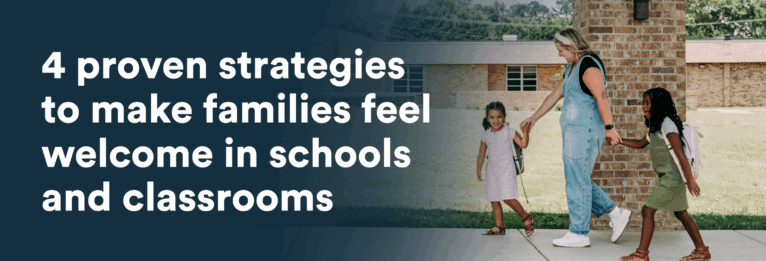Written by Paige DeLozier
Why family engagement matters in today’s classrooms
The US official poverty rate, as measured by the American Community Survey (ACS), was 16.3% for children (people under the age of 18) in 2022. This was 3.7 percentage points higher than the national overall rate. (Benson, 2023).
Of course, these numbers are discouraging when considering the research most people are familiar with, which shows students from lower socioeconomic households and communities developing academic skills more slowly than their peers living in higher socioeconomic communities.
Wait, there’s hope!
Family engagement has proven to be two times as effective in predicting a student’s success as the family’s socioeconomic status (Mapp & Henderson, 2002). So, your most valuable resource in supporting these students and families is the families themselves!
Many adults endured trauma with their educational experience, or had no educational experience at all, and therefore are hesitant about involving themselves too deeply in their children’s school lives. We have an opportunity—a responsibility—to change that.
Here are four ways to make families feel more welcome in school buildings and classrooms, engaging them in a positive and inclusive community that supports learning and growth.
Personal welcomes and ongoing communication
You will never know each family’s full experience with the education system, and some will carry with them a lot of baggage surrounding that experience. When you, as the teacher, offer something as simple as a welcome message and meaningful check-ins, families can begin to let their guard down.
At TalkingPoints, helping you meaningfully connect with each of your families is our bread and butter. We make communicating with families through text messages easy and efficient. Here’s how we do it:
- Text-first model – reaches 99% of families with important messages and announcements
- Industry-leading translation – our proprietary translation in over 150 languages helps you reach all families in their home language, enabling them to engage and support their student
While using TalkingPoints is an accessible and inclusive way to engage families, it’s important to keep in mind the types of communication that go on when a family member enters your school building.
Are they greeted within moments of entering? Is it clear where to go and who they can ask for help? Do they feel they can communicate with any of the staff they encounter and receive an empathetic and helpful response? School faculty and staff should regularly reflect on these types of questions when evaluating their family engagement goals.
When considering these connections in school, it’s also helpful to think about how to maintain them digitally. TalkingPoints includes things like Family Check-Ins, school calendar-aligned pre-built notes that keep families up-to-date and connected to what’s happening. It also serves to open the door for them to ask questions.
![]()
Assess your district’s family engagement strategy and uncover growth opportunities:
Representation in school culture
From the books in your library, to the staff in your office, to the languages on your signs, to the posters on your walls, representation matters. Awareness of the ethnicities, cultures, religions, and races within your school community is crucial to making all families feel welcome and safe in your school building.
One of the simplest yet most impactful steps you can take for many families is to communicate pertinent and timely information to them in their home language. Communicating with anyone in their home language shows a deep respect, making them feel seen and valued, and is something families appreciate.
Representation in engagement is a continuous process that evolves as new families join the community. Each learning experience offers an opportunity for growth and deeper family involvement.
Collaborate with families on student goals
A school is a community of students, educators, and families. Assuming families hold good intentions and want the best for their child, a community—a team—can only truly work together if goals are aligned.
The good news is that this already occurs for so many students and families in IEP meetings! A team of professionals comes together and discusses a plan designed to help a particular student overcome or manage obstacles to their academic and social success.
In a much less formal way, many teachers already do this for most of their other students as well. They keep regular meetings or discussions with families to make sure they’re on the same page about their child’s progress and needs.
The idea of setting goals with all families as a school, however, can be a bit overwhelming. A great first step is to invite all families to be part of the conversation, and valuing their input. This kind of open discussion is essential to a truly engaged and successful school community.
The next time your school has a decision to make, invite families to come and learn about the options and share their input. Many school-wide decisions that directly affect their children, and their insights might surprise you.
![]()
Check out this blog and free resource
![]()
Inclusive engagement opportunities for all families
Does every family have a stay-at-home mom who is crafty and loves to be in the classroom three days a week? Absolutely not.
Every family is different, with individual personalities, working hours, skills, and things to offer. How do you provide opportunities for all members of each family to feel welcome to participate in their children’s education?
Let’s brainstorm!
Working and stay-at-home
Working family members may never be able to come into the classroom, but keeping them engaged can be done digitally via email or text message. It cannot be assumed they don’t care simply because they can’t be there. Stay-at-home caregivers can come into the building more often than working families.
Introverts and extroverts
Sometimes it all comes down to personality type when you’re considering participation opportunities. Not all family members feel comfortable reading one-on-one with a child they don’t know, but some will! To find out what kind of engagement each family member wants to have in your classroom, consider making a list of options and having them circle the ones they’d be willing or able to do.
Resourced and under-resourced
These categories can refer to a few things; the most obvious would be income. Sometimes, engaging families in class or school activities requires a cost, like asking them to bring a snack to a class party. Consider options for families who may not be able to contribute in this way but want to be part of the celebration. Can they help you cut out decorations instead?
Another way to view it would be as access to physical resources or even time. You’ll find that some families, for instance, may not own a vehicle while others own two, making parent-teacher conference scheduling complicated.
The first step in getting all these different types of family members involved in your classroom is taking the time to understand their circumstances.
Students become part of a community when they enter a school—it becomes their second family. Connecting these two families only makes sense, engaging in partnership toward academic, social, and emotional success.
![]()
See TalkingPoints in action—watch a 90-second explainer video.
![]()
Celebrating 10 years of partnership and impact
For a decade, TalkingPoints has supported students, families, and educators through the power of effective family-school partnerships. As an education technology nonprofit, our award-winning communication and family engagement platform has improved outcomes for districts and students across the country.
We connect 9 million+ educators, students, and family members annually and have facilitated more than one billion conversations—building trust, fostering relationships, and fueling student success. Named by Common Sense Education as “the best overall family communication platform for teachers and schools,” TalkingPoints drives measurable gains in attendance and academic achievement, backed by rigorous, causal research.
Join us in building a future where every child has the support they need to thrive.
![]()
Citations
American Psychological Association. (2017a). Education and Socioeconomic Status. American Psychological Association. https://www.apa.org/pi/ses/resources/publications/education
Benson, C. (2023, December 21). Child poverty rate still higher than for older populations but declining. Census.gov. https://www.census.gov/library/stories/2023/12/poverty-rate-varies-by-age-groups.html
Henderson, A. T., Mapp, K. L., & Averett, A. (2002). A new wave of evidence: The impact of school, family, and community connections on Student Achievement. National Center for Family & Community Connections with Schools.



